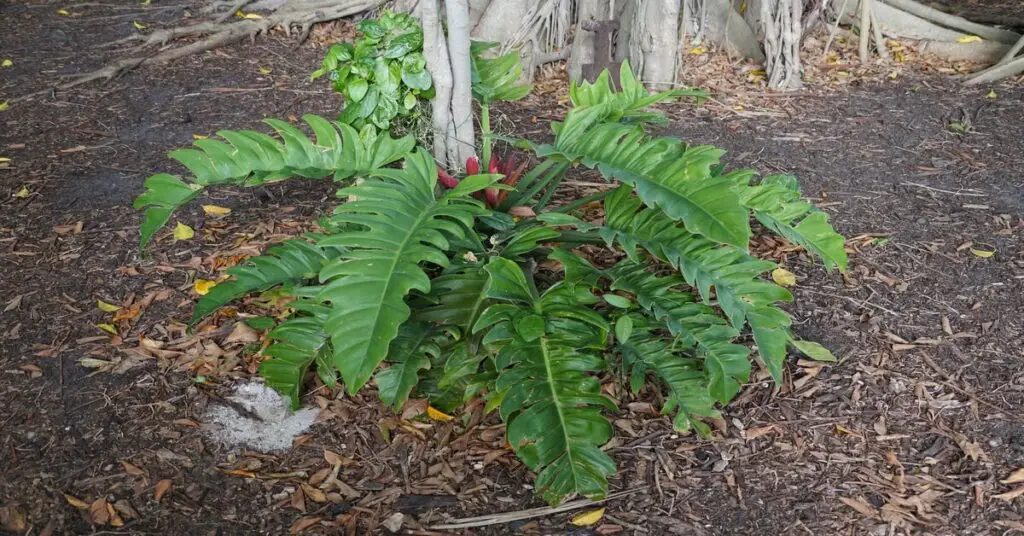The Tiger Tooth plant, also known by its scientific name, Philodendron’ Jungle Boogie’, is a popular houseplant believed to be a Thai hybrid.
It earns its common name due to its serrated foliage. The tooth-like edges of this Araceae-family plant’s leaves are texture-heavy and dramatic. The Jungle Boogie plant can appear lush and bushy with long stems and growth in a rosette formation.
Philodendron Jungle Boogie Care
Jungle Boogie Philodendrons don’t require significant care. They’re considered one of the easiest houseplants to grow. Not only are these aroids easy to care for, but they also are quick to reach their mature size.
Below, you’ll discover just how low-maintenance and forgiving these Philodendrons are.
Soil
Jungle Boogie plants prefer standard soil mixes featuring coco coir, vermiculite, or perlite. As long as the soil mix has decent aeration and drainage, your Boogie should grow just fine.
Watering
Like many houseplants, Jungle Boogie Philodendrons neither like super dry nor overly moist soil.
You’ll know it’s time to water your Jungle Boogie when the top two inches of its soil are dry. Please give it a decent soaking when it’s watering time.
Lighting
Jungle Boogies prefer lower lighting conditions, so aim to provide bright, indirect light throughout the day.
Light from an east- or west-facing window is most appropriate for the Jungle Boogie plant. Because they can tolerate low lighting, they don’t have to be near the window.
If your plant’s leaves start to look burned or scorched, they may be receiving too harsh lighting. Move your plant to an area with less illumination.
Humidity & Temperature
Keep your Jungle Boogie’s temperature between 65 and 90 degrees Fahrenheit. Like most houseplants, this Philodendron is a big fan of humidity, preferably 70% or higher humidity levels. If your home lacks humidity, consider purchasing a humidifier.
In Zones 9 through 11, the Jungle Boogie plant can also be grown outdoors if the temperature and humidity level permit.
Fertilizing
Fertilize your Tiger Tooth with a water-soluble fertilizer once a month during its prime growing seasons. Do not fertilize in the winter, as extra nutrients are unnecessary during this slow growth period.
Overfertilizing or fertilizing your Philodendron during its non-active growth seasons can lead to brown leaf tips or curled tips.
Propagation
Tiger Tooth plants are easy to propagate. You can do so via traditional stem cutting or by rooting a cutting in water before transplanting to soil. Root growth should be noticeable within two to three weeks if propagation is successful.
Diseases & Pests
Jungle Boogies are susceptible to common Philodendron diseases such as bacterial blight and leaf spot. To avoid bacterial diseases, prevent overhead watering. Remove any leaves that appear to be infected.
Scale insects, spider mites, brown thrips, and fungus gnats are some of the customary pests of the Jungle Boogie. Check underneath leaves if you suspect a possible pest infestation.
Toxicity
Like other Philodendrons, consuming parts of the Jungle Boogie can be toxic to humans and animals. While usually non-lethal, it can trigger oral swelling and digestive distress.
Jungle Boogie Philodendron Flower
In optimal conditions, the Jungle Boogie Philodendron will bloom. However, flowering is uncommon indoors but not impossible.
If it blooms, its flowers will be a pinkish-orange, like a sunset, and feature a spathe.
Philodendron Jungle Boogie vs Ring of Fire
The main difference between the Philodendron Ring of Fire and Jungle Boogie is its coloring. Jungle Boogies have green foliage. However, Ring of Fire plants feature red, orange, and yellow hints.

